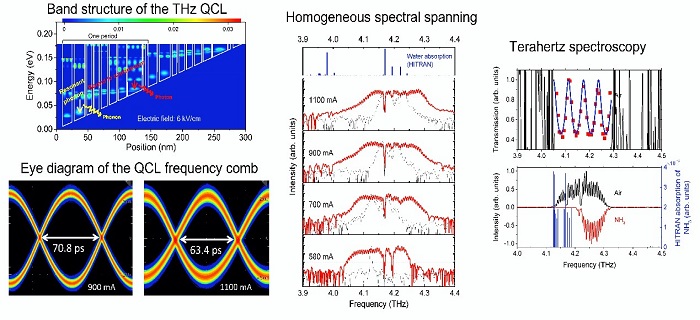Homogeneous spectral spanning of terahertz quantum cascade laser-based frequency combs
Date:19-07-2017 | 【Print】 【close】
The researchers at the Key Laboratory of Terahertz Solid-State Technology, Shanghai Institute of Microsystem and Information Technology, Chinese Academy of Sciences, achieved ultra-broad dynamic range, homogeneous spectral spanning terahertz frequency combs based on the high performance, electrically pumped quantum cascade lasers. Employing the microwave modulation technique, the long-cavity quantum cascade laser demonstrates broadband spectral coverage which continuously spans over 330 GHz frequency range centered at 4.2 THz. The frequency coverage achieved in this work is the record for the terahertz quantum cascade lasers based on the bound-to-continuum design. Using the homogeneous spectral spanning laser, the research team successfully demonstrated the terahertz spectroscopic analysis for GaAs etalon and ammonia gas. The research entitled “Homogeneous spectral spanning of terahertz semiconductor lasers with radio frequency modulation” was published in Scientific Reports on March 08, 2017 (W. J. Wan, H. Li, T. Zhou, and J. C. Cao, Sci. Rep. 7, 44109 (2017); Link: http://www.nature.com/articles/srep44109).
Since the work of frequency comb was awarded the Nobel prize in physics in 2005, the research on frequency combs in different wavelength ranges becomes the hot research topic. The frequency comb consists of stable frequency lines which are evenly spaced. Because of the highly stabilized frequencies, the frequency comb can be regarded as a ruler and then used for many applications, e. g., absolute frequency measurements, high resolution spectroscopy, and so on. In the terahertz frequency range, due to the lack of efficient radiation sources, it is a hard work for demonstrating frequency comb operation. Among all the terahertz sources, the electrically pumped terahertz quantum cascade laser is the most suitable source that can be used for high power comb generation in the terahertz regime. Based on the results presented in this work, the researchers at the institute is planning to develop dual-comb spectroscopy technology for high spectral resolution terahertz applications.
This work was supported by the “Hundred-Talent” Program of the Chinese Academy of Sciences, the Major National Development Project of Scientific Instrument and Equipment (Grant No. 2011YQ150021), the 973 Program of China (Grant No. 2014CB339803), the National Natural Science Foundation of China (61575214 and 61404150), and the Shanghai Municipal Commission of Science and Technology (14530711300, 15560722000 and 15ZR1447500).

